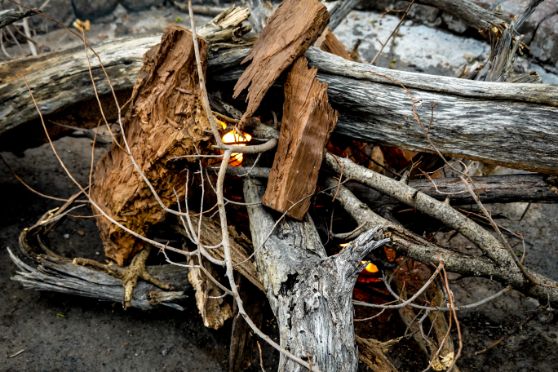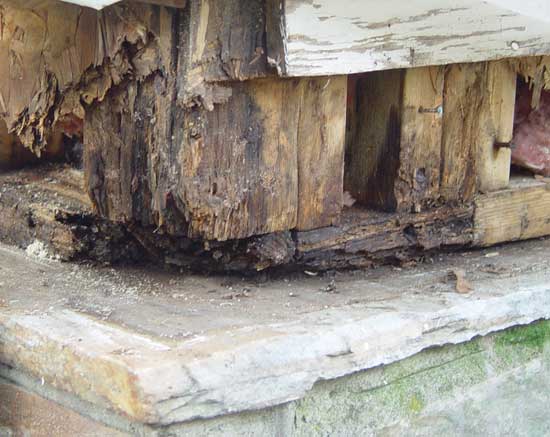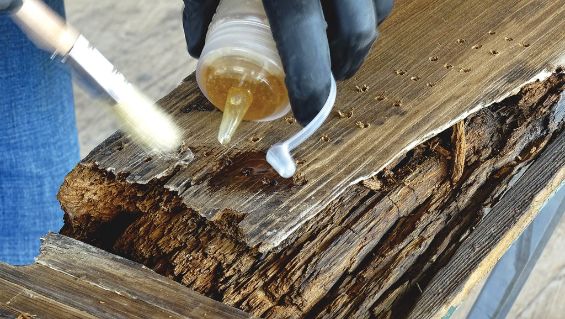It can be extremely annoying and dangerous to have rotted wood in your house. This manual demonstrates how to identify and repair rotted wood for homeowners and do-it-yourselfers.
Every homeowner will experience wood rot at some point in his life. The result is that solid lumber quickly turns to mush as a result of moisture and fungi. The wood rot caused by water can, fortunately, be repaired using a variety of techniques. Either you decide to replace the wood entirely or you decide on a repair method. Everything hinges on you.
Methods to Repair Rotted Wood
One has a good number of options at their fingertips for fixing the rotten wood. However, you must first identify the underlying causes of the rot and take action to stop it before you can repair it.
If you want to repair the rotted wood, measuring the rot’s depth is essential. Wood rot is extremely dangerous, and if you don’t treat it seriously, it could ruin your interior, doors, and flooring completely.
Wood Restore
This method can be applied to areas where rot is just beginning, usually on parts that are visible, like the corner of a table, a door, a wardrobe, etc. Filling minor rotted areas of the wood involves applying multiple layers of the product wood Restore. This method’s disadvantage is that it cannot be applied in areas where wood rot is prevalent.
- With the aid of a flathead screwdriver, chisel, or claw, remove the rotten portion of the wood.
- Remove all of the rotten wood, leaving the sturdy, healthy portion behind.
- A clean surface is necessary because a wood restore cannot adhere to rust or primer. To get rid of all the dust and paint from the rotted area of the wood, use sandpaper.
- On the damaged area, repeatedly coat it with wood restoration (a product available to repair rot).
Epoxy Filling
For wooden furniture whose size and shape make replacement impossible, the epoxy filling is used. Epoxy filling strengthens the wood and renders it moisture-proof for many years in addition to repairing the rotted area. The best place to use epoxy is on a rotted wood surface that is not hanging, like a door.
- To repair the rotted wood, purchase epoxy fillers from a local hardware store.
- It is a liquid plastic that becomes harder when exposed to air.
- Remove the rotten softwood first.
- With the help of a putty knife, combine the two parts of the epoxy filler—the resin and the hardener.
- This epoxy mixture was carved into the wood.
- Pain the wood. Done!
Removing and Replacing the Rotted Wood

This technique is only applied if the rot is severe and cannot be restored to its original appearance. It requires patience and knowledge to replace the rotted wood. Only professionals use this technique to completely replace the part with a fresh piece of wood.
Many tools are required to do this repair e.g, handsaw, wood, claw, chisel, hammer, screws, etc.
- Make a nearly 2-inch extra mark on the wood where the rot has taken hold so you can cut it out.
- Cut the marked part with a reciprocating handsaw. To avoid damaging the area that hasn’t been marked, proceed with extreme caution. To gain experience using it, try practicing with the reciprocal handsaw on a piece of unrelated wood.
- Use a chisel and hammer to remove the piece. Use a chisel and a hammer to completely remove the rotted wood from the wood by breaking it into pieces.
- Cut a piece of wood the same size to fill the hollow area. To do this, use a saw and a measuring tape.
- On the side of the wood piece that will fit with the other wood, apply wood glue.
- With the remaining portion, properly affix it.
- To make it stronger, drill screws.
- Paint it out.
You can check out more information we have on Termite Damage Vs Wood Rot: What Are They?
Patching With Wood Fillers
Another excellent option for dealing with rotted wood is wood fillers. The holes left by rot are filled using a mixture of wood filler and hardener. In order to repair rotted holes in doors, tables, floors, etc., wood fillers are frequently used.
- Push your fingers into the wood to gauge the extent of the rot.
- Use a chisel or another spiked tool to remove the rotted part once you’ve located it.
- Larger holes cannot be filled with wood filler. Prior to applying wood fillers, make sure the holes have replacement wood.
- On a plastic plate, combine the hardener and wood filler. In just 15-20 minutes, it will be dry. So do this step fast.
- Use a putty knife to apply a small amount of the mixture to the rotted area. Put this mixture into the entire gap.
- Sandpaper and a chisel can be used to remove extra fillers.
- Paint the surface.
Can Rotted Or Damaged Wood Be Repaired?
Absolutely! Remove the rotting from the original board or joists before attempting to repair rotten wood. Then, using a plastic putty knife, fill the surrounding area with a soft wood polyester filler or a wood patch. For strength and resilience, this material fills the space and hardens.
Discovering the appropriate time for the replacement or repair of rotten wood is crucial. The repair won’t be very effective if the wood is extremely rotten. Replacement of the component is advised in this situation.
How to Identify Rotten Wood?

Wet rot and dry rot are the two distinct types of rot. Wet rot, which more frequently affects extremely damp wood, can also damage plaster, wallpaper, and carpets.
While wet rot may not initially seem to be a major problem, it can quickly lead to issues because it causes the wood to soften over time. In timber, around windows, in cellars, and on roofs, it occurs most frequently.
Wet rot-affected wood can appear darker than healthy timber, feel soft and pliable, be cracked or crumbly, and have small patches of fungus growth. It may also have a musty, damp smell.
If a screwdriver or knife easily enters the wood, you probably have wet rot. However, compared to wet rot, dry rot requires less moisture to establish itself.
In order to spread, the fungus known as dry rot consumes wood, which can be harmful to the stability of a building. The main causes of dryness are leaks, dampness, and inadequate ventilation.
As dry rot spreads, its appearance changes. It can have a fine white thread-like appearance in the beginning; as it develops, it takes on a more cotton-wool-like appearance. It more closely resembles a mushroom with an orange tinge when it develops its “fruit”
Timber that has been exposed to dry rot may crumble, shrink, or split into cubes. Because it frequently occurs beneath the floorboards, dry rot in flooring can be difficult to spot. However, if you observe that the floor feels bouncy, that it is receding from the skirting boards, or that it is extra creaky, you may have dry rot.
In addition to wood, masonry can also be impacted by dry rot. It’s crucial to get in touch with a professional right away to have the issue verified once you notice dry rot.
Regardless of the type of rot you have, you will probably be able to smell dampness before you actually see the rot.
How to Determine If Rotten Wood Needs to Be Repaired Or Replaced?

The durability and stability of the beam will be compromised if a piece of wood is too rotten, which is a well-known test to determine whether it needs to be replaced or repaired. The most prominent telltale signs of rotten wood are:
- Deep cracks across the grain
- Off-white fibers of the fungus
- Growth of mushroom-like substances on the surface
- Off-white or yellow tinge on the brickwork
In these situations, it is preferable to replace rotten wood. The only option is not always a replacement, though. Although they are still stable and well-supported, wooden beams can occasionally rot in some places. This problem is easily fixable.
Using a knife or screwdriver to poke in the wood will allow you to determine whether it is rotten. Typically, rotten wood is tender and soft. It’s likely that new wood needs to be used if the knife sinks in more than 1/8″ (Prime).
To properly decide whether to repair or replace wooden beams, it’s critical to recognize when the wood is rotten.
How to Prevent Rot?
Proper ventilation is the key to preventing rot. When condensation pools and sits on the wood for an extended period of time, it can rot the area around the windows. When cooking, keep windows open frequently or use a dehumidifier to help with airflow and minimize condensation.
As one way for water to contact the wood is through caulk or sealant cracks around doors and windows, these should be repaired.
Many types of wood are frequently pre-treated, making them rot-resistant. The source and cause of rot can frequently be found in the ground, so if you’re looking for decking or fencing, make sure the wood is suitable for contact with the ground.

When possible, remove any standing water from the decking to help prevent rotting. This shouldn’t be a problem with the proper protection, but doing this is generally good maintenance.
How to Care for Wood?
Wood rot can be avoided in the home by taking good care of the wooden furniture. Wooden fixtures can be sealed with wood stains, paint, or a clear sealer to guard against fungus, termites, water damage, and other harm.
This is what you can do:
- Your home should be painted or repainted every five years to protect the wood.
- Every year, make sure to clean up the mildew on your wood furniture and accessories so it doesn’t turn into mold.
- Clean wood using warm soapy water and a scrubbing brush to scrape dirt and other debris off
FAQs
How Much Does Wood Rot Repair Cost?
A small, easy-to-access area of wood dry rot will cost $100 to $300 to repair. Dry rot repair for siding typically costs around $1,000 but can cost as much as $2,500.
Does Rotted Wood Continue Rotting?
Always take care of wood rot as soon as you can. It not only gets worse over time, but it may even render your structures dangerous.
How Do You Get Rot Out of Wood?
If there’s any surface rot or paint on the wood, you can use a paint scraper or coarse sandpaper to get rid of it. Apply a few coats of a wood restorer to any soft wood to help it become more solid after the rotted wood and any paint have been removed. Use wood filler or epoxy to plug the holes. The surface should then be smoothed out.





